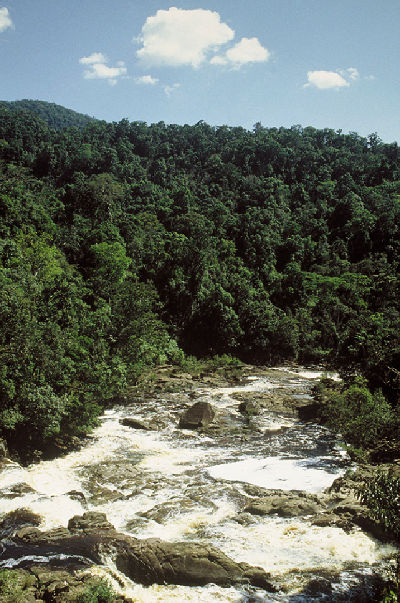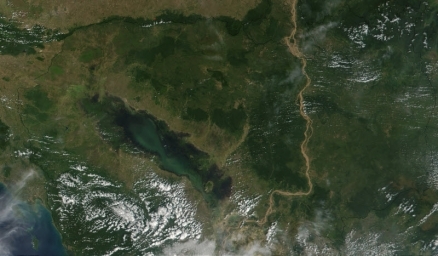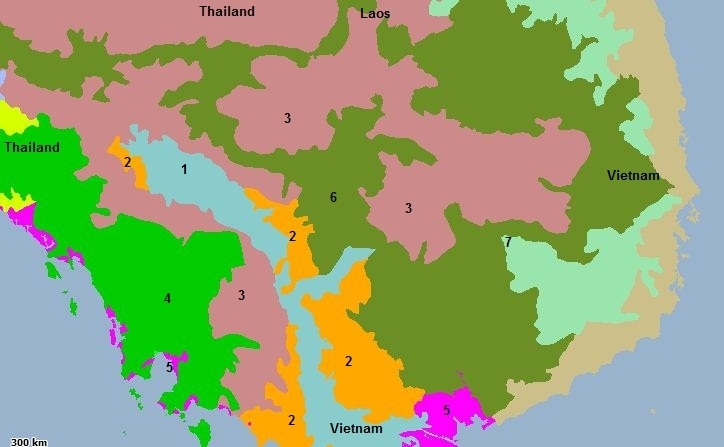Ecoregions of Cambodia
Contents
Ecoregions of Cambodia
Ecoregions of Countries Collection 
Cambodia has seven ecoregions that occur entirely or partly within its borders:
- Tonle Sap freshwater swamp forests
- Tonle Sap-Mekong peat swamp forests
- Central Indochina dry forests
- Cardamom Mountains rain forests
- Indochina mangroves
- Southeastern Indochina dry evergreen forests
- Southern Annamites montane rain forests
Tonle Sap freshwater swamp forests
The swamp shrublands and forest of the Tonle Sap Freshwater Swamp Forests ecoregion include two forest associations that have been described for the extensive floodplain area of Tonle Sap, a short tree shrubland covering the majority of the area and a stunted swamp forest around the lake itself. Similar swamp forests are also present along floodplains of the Mekong and other major rivers in Cambodia. Although most of the ecoregion, including the lake, was declared a protected area recently, it was too little too late. The protected area is a paper park with no protection or management, and it was declared protected after most of the habitat had been cleared for agriculture. This is prime rice-growing habitat.
Tonle Sap-Mekong peat swamp forests
The Tonle Sap-Mekong Peat Swamp Forests are only a small vestige of their former range and function. They extend over areas permanently inundated with shallow freshwater, although the region as mapped includes mosaics of swamp forest and herbaceous wetland interposed with upland areas of dry forest. However, care must be given in separating permanently flooded swamp forests of southeast Asia from seasonal swamp forests that characterize extensive areas of the Tonle Sap Basin and the floodplain of major Cambodian rivers. More than 90 percent of this ecoregion has been converted to scrub or degraded forests. Intensive agriculture and the alteration of the hydrodynamics of the river systems in the region have altered the natural river fluctuations, adversely affecting the remaining native vegetation.
Central Indochina dry forests
The Central Indochina Dry Forests ecoregion covers most of central Indochina and harbors an outstanding assemblage of threatened large vertebrates that characterize the mammal fauna of the Indo-Pacific region. Just half a century ago large populations of megaherbivores such as Asian elephants, banteng, kouprey, gaur, wild water buffalo, and Eld's deer roamed and grazed in these dry woodlands. Where human densities were still low, the landscapes were dominated by large herds of wildlife reminiscent of the savannas of east Africa. Large carnivores such as tigers, Clouded Leopards, leopards, and packs of wild dogs hunted these herbivores. Unfortunately, throughout the ensuing years habitat loss and hunting for trade have exacted a devastating toll on these species. Some species have even become extinct. The two rhinoceros species, the Javan and the Sumatran are now extinct in this ecoregion, as is Schomburgk's deer. The kouprey probably is globally extinct, although intermittent reports from remote areas of northern and eastern Cambodia keep hopes alive. Among the other species, the tiger, Asian elephant, Eld's deer, banteng, and gaur are endangered.
Cardamom Mountains rain forests
 Central Cardamom Mountains, Cambodia Photograph by Barney Long / Fauna & Flora International The Cardamom Mountains Rain Forests ecoregion sits astride the Cardamom Mountains (locally known as Kravanh) and the Elephant Range (locally known as Dom rei) in southwestern Cambodia and extends slightly across the border into southeastern Thailand.
Central Cardamom Mountains, Cambodia Photograph by Barney Long / Fauna & Flora International The Cardamom Mountains Rain Forests ecoregion sits astride the Cardamom Mountains (locally known as Kravanh) and the Elephant Range (locally known as Dom rei) in southwestern Cambodia and extends slightly across the border into southeastern Thailand.
It is separated from the nearest other rain forest by the vast, dry Khorat Plateau in central Thailand to the north and east and by the Gulf of Thailand in the west.
The Cardamom Mountain rain forests are considered by some to be one of the most species-rich and intact natural [[habitat]s] in the region, but they are also one of the least explored.
Because of the low human population of this ecoregion, the forests in Cambodia are relatively intact; however, the areas in southeastern Thailand have been greatly reduced and now exist only in a few protected areas in hilly regions. Sixteen protected areas cover about 14,500 km2 (33 percent) of the ecoregion (Table 2). Six of these protected areas—Aural, Phnom Bokor, Botum-Sakor, Roniem Daun Sam, Khao Ang Ru Nai, and Phnom Samkos—are larger than 1,000 km2. Phnom Samkos National Park exceeds 3,000 km2.
Despite this high level of formal protection, very few reserves have effective management and workforces; they are paper parks. Several are now under threat from illegal logging operations and from adjacent concessions that encroach on the unprotected protected areas. The wildlife trade has also resulted in widespread hunting throughout Cambodia and Thailand, exacting a heavy toll from endangered wildlife populations. The widespread presence of antipersonnel land mines pose severe threat to both wildlife and humans (including researchers).
Indochina mangroves
Among the most diverse and extensive mangrove ecosystems in the world, this ecoregion provides extremely important habitat for some of the world's rarest waterbirds. The largest block of Indochina Mangroves in the Mekong River delta suffered large-scale habitat loss from defoliants sprayed during the Vietnam War.
Mangrove forests occur in coastal areas of regular flooding by tidal or brackish water and develop on saline gleysols. The extent of mangroves in [[coastal] areas] of Thailand, Cambodia, and Vietnam was once high, but much of this area has been destroyed. Extensive mangrove forests once occurred in the areas of Veal Renh and Kompong Som Bays in Cambodia. The absence of more extensive mangrove stands in Cambodia is strongly related to the rocky coastline and lack of major estuaries or river deltas.
This ecoregion is highly threatened in nearly every site where it occurs. About half of the mangroves in southern Vietnam were destroyed by Agent Orange, tank movements, and bombing during the war. Since then, however, the government has launched a large-scale reforestation program. Although protected areas have been created to conserve these mangroves-seven small protected areas (average size of only 117 square kilometers (km2)) cover a mere 820 km2 (3 percent) of the ecoregion-the majority of the ecoregion is threatened by a multitude of human activities (table 1).
Southeastern Indochina dry evergreen forests
The Southeastern Indochina Dry Evergreen Forests ecoregion is globally outstanding for the large vertebrate fauna it harbors within large intact landscapes. Among the impressive large vertebrates are the Indo-Pacific region's largest herbivore, the Asian elephant (Elephas maximus), and largest carnivore, the tiger (Panthera tigris). The list includes the second known population of the critically endangered Javan rhinoceros (Rhinoceros sondaicus)-comprising a handful of animals in Vietnam's Cat Loc reserve-Eld's deer (Cervus eldi), banteng (Bos javanicus), gaur (Bos gaurus), clouded leopard (Pardofelis nebulosa), common leopard (Panthera pardus), Malayan sun bear (Ursus malayanus), and the enigmatic khting-vor (Pseudonovibos spiralis), known to science only by a few horns. But the ecoregion's conservation priority does not rest merely on its charismatic biodiversity. Importantly, it also represents a rare instance of a nonmontane ecoregion with large expanses of intact habitat that can allow viable populations of these species to survive over the long term. Unfortunately, all is not well in this haven, for plans to log Cambodia's forests, where most of the large habitat blocks lie, will result in large-scale habitat loss and fragmentation. Therefore, the ecoregion has been placed on the critical list.
About two-thirds of the original forest in this ecoregion has been cleared or seriously degraded, especially in Vietnam and Thailand, but the habitat is relatively intact in Cambodia. A few large forest blocks also remain in Thailand and Laos. The thirty-one protected areas in this ecoregion cover 22,230 kilometers2 (18 percent) of the ecoregion. Overall, the protected areas in this ecoregion are large, with an average size of almost 750 kilometers2.
Most of the forests in Vietnam have already been replaced by plantations. Shifting agriculture has further degraded some areas of this ecoregion. But the greatest threats now are from large-scale logging concessions that have been granted to multinational companies by the Cambodia government; therefore, the conservation status has been changed from relatively stable to critical.
Hunting to supply the huge wildlife trade has created empty forests throughout most of the ecoregion. From small, homemade crossbows used to kill small mammals for local consumption to bombs hidden in baited traps to kill tigers and pitfall traps for elephants, hunting has taken a very heavy toll on wildlife. The ravages of war and conflict have also had lasting effects; mines and bombs scattered across the landscape and the easy availability of automatic weapons that have replaced the crossbows have had deadly consequences.
Southern Annamites montane rain forests
in the remote montane forests of Kontuey Neak, or "the dragon's tail"-in the extreme northwest of Cambodia, where the boundaries of Cambodia, Laos, and Vietnam meet-is globally outstanding for its biodiversity. The intact forests of the ecoregion are little explored; it takes two weeks of intense walking and braving hazards such as mines and bombs that lie scattered throughout the landscape to get to some of the remote areas of the ecoregion. But the known flora and fauna attest to the region's biological diversity, which includes some of Asia's charismatic fauna. Among the larger vertebrates, the tiger (Panthera tigris), Asian elephant (Elephas maximus), douc langur (Pygathrix nemaeus), gibbon (Hylobates gabriellae), wild dog (Cuon alpinus), sun bear (Ursus malayanus), clouded leopard (Pardofelis nebulosa), gaur (Bos gaurus), banteng (Bos javanicus), and Eld's deer (Cervus eldii) are better known.
Context
Ecoregions are areas that:
[1] share a large majority of their species and ecological dynamics;
[2] share similar environmental conditions; and,
[3] interact ecologically in ways that are critical for their long-term persistence.
Scientists at the World Wildlife Fund (WWF), have established a classification system that divides the world in 867 terrestrial ecoregions, 426 freshwater ecoregions and 229 marine ecoregions that reflect the distribution of a broad range of fauna and flora across the entire planet.
See also:

